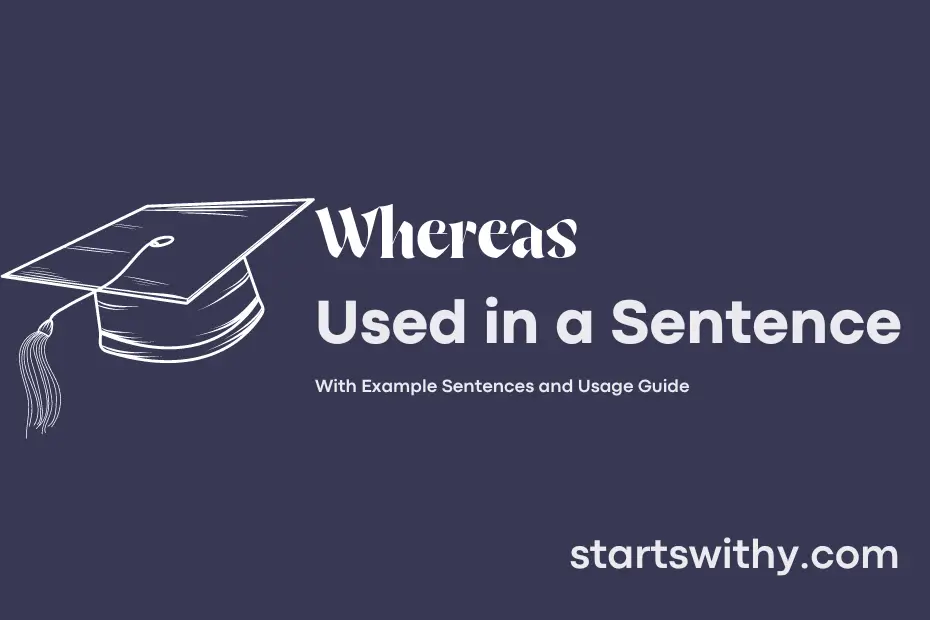Have you ever wondered about the proper way to use the word “whereas” in a sentence? This transitional adverb is commonly employed to contrast or compare two different pieces of information or ideas.
In English grammar, “whereas” is used to establish a relationship between two clauses or phrases. It introduces a contrasting or supplementary statement that complements the main idea presented in the preceding clause.
7 Examples Of Whereas Used In a Sentence For Kids
- I like to play outside, whereas my sister prefers to stay indoors.
- I enjoy eating fruits, whereas my friend likes to eat chocolates.
- I have a pet dog, whereas my neighbor has a pet cat.
- I like the color blue, whereas my best friend likes the color red.
- I go to school in the morning, whereas my cousin goes to school in the afternoon.
- I wear glasses to see better, whereas my teacher does not wear glasses.
- I love to sing, whereas my brother loves to dance.
14 Sentences with Whereas Examples
- Whereas many colleges offer a wide range of extracurricular activities, some students prefer focusing solely on academics.
- Whereas some students find it challenging to balance academic responsibilities with part-time jobs, others excel in managing both efficiently.
- Whereas the campus library provides a quiet study environment, many students prefer to study in the bustling atmosphere of cafes.
- Whereas some students prefer taking notes by hand, others find it more convenient to type notes on their laptops during lectures.
- Whereas some students thrive in group study sessions, others prefer studying alone to enhance their focus.
- Whereas some students excel in written exams, others showcase their knowledge better through practical assessments and presentations.
- Whereas some students prefer studying in the comfort of their dorm rooms, others thrive in the energy of communal study spaces.
- Whereas some students prefer to buy textbooks, others opt for cost-effective alternatives such as renting or borrowing books from the library.
- Whereas some students prefer studying in the early morning, others find that they are most productive during late-night study sessions.
- Whereas attending every lecture is crucial for some students to grasp concepts, others prefer self-studying and rely on lecture recordings as a supplementary resource.
- Whereas some students thrive under pressure and excel in exams, others prefer to study consistently throughout the semester to avoid last-minute cramming.
- Whereas some students enjoy participating in college events and competitions, others prioritize internships and practical work experience for their career advancement.
- Whereas some students prefer digital study tools like online flashcards, others still find traditional methods like writing on index cards more effective.
- Whereas part-time jobs can provide valuable work experience, some students find it challenging to juggle work commitments with academic responsibilities.
How To Use Whereas in Sentences?
To use “Whereas” in a sentence, it is important to understand its purpose and how it can be applied effectively. The word “Whereas” is typically used to introduce a contrasting or qualifying statement, setting up a comparison or contrast between two parts of a sentence.
When using “Whereas,” it is crucial to remember that it is often used to provide background information or context that helps to explain or support the main idea of a sentence. For example, “I enjoy cooking, whereas my sister prefers baking” sets up a comparison between two related activities.
Here are a few tips for using “Whereas” effectively:
-
Clarity: Be clear in your use of “Whereas” to ensure that it is used to introduce a clear contrast or comparison.
-
Placement: Place “Whereas” at the beginning of a sentence to signal the introduction of a contrasting idea.
-
Punctuation: Use a comma after “Whereas” to separate the contrasting ideas in the sentence.
-
Stay concise: Keep your use of “Whereas” concise and to the point, avoiding unnecessary repetition or wordiness.
Remember, practice makes perfect! Try using “Whereas” in your writing to add depth and nuance to your sentences.
Conclusion
In writing, the use of sentences with ‘whereas’ serves to present contrasting or opposing ideas, highlighting differences or distinctions between two or more concepts. These sentences are structured to juxtapose clauses that illustrate conflicting information or provide context for comparison. By using ‘whereas’ in a sentence, writers can effectively emphasize divergent perspectives or clarify distinctions between various subjects or arguments.
Whether used in formal academic writing or everyday communication, sentences with ‘whereas’ play a crucial role in conveying complexity and nuance in language. By signaling a shift in thought or introducing a counterpoint, ‘whereas’ sentences help readers to better understand contrasting viewpoints and make connections between different ideas. Ultimately, the deliberate use of ‘whereas’ enhances the clarity and depth of communication, allowing for a richer expression of divergent perspectives and contributing to the overall coherence of written text.



